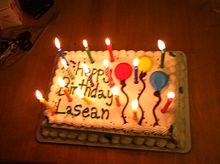The history of birthday cake
In classical Roman culture, 'cakes' of flat rounds made with flour containing nuts, leavened with yeast, and sweetened with honey were occasionally served at special birthdays, but more often at weddings as in Ancient Greece. Cakes have existed since 1768. In early Europe, the words for cake and bread were virtually interchangeable; the only difference being that cakes were sweet while bread was not. In the 15th century, bakeries in Germany conceived the idea of marketing one-layer cakes for customers' birthdays as well as for only their weddings, and thus the modern birthday cake was born. During the 17th century, the birthday cake took on more or less its contemporary form. However, these elaborate cakes, which possessed many aspects of contemporary cakes (such as multiple layers, icing, and decorations), were only available to the very wealthy. Birthday cakes became more and more proletarianized as a result of the industrial revolution, as materials and tools became more advanced and more accessible. Birthday Cake [edit]Tradition of putting candles on birthday cake Birthday cake (with No. 53 candle, roasted chicken and banana, Goldilocks Bakeshop) The tradition of placing candles on birthday cake is attributed to early Greeks, who used to place lit candles on cakes to make them glow like the moon. Greeks used to take the cake to the temple of Artemis. Some[citation needed] say that candles were placed on the cake because people believed that the smoke of the candle carried their prayers to gods. Others believe that the custom originated in Germany where people used to place a large candle in the centre of the cake to symbolize ‘the light of life’. In present times t

o, people place candles on birthday cakes and a silent wish is made before blowing out the candle. It is believed that blowing out all candles in one breath means the wish will come true and the person will enjoy good luck in the coming year. Some also smear out the name of the person before slicing of the cake to bring good luck. The earliest reference to the tradition of blowing out the candles was documented Switzerland in 1881. Researchers for the Folk-Lore Journal recorded various "superstitions" amongst the Swiss middle class. The following statement was recorded, "“A birthday-cake Moussest have lighted candles arranged around it, one candle for each year of life. Before the cake is eaten the person whose birthday it is should blow out the candles one after another.”Artemis was one of the most widely venerated of the Ancient Greek deities. Her Roman equivalent is Diana. Some scholars[1] believe that the name and indeed the goddess herself was originally pre-Greek.[2] Homer refers to her as Artemis Agrotera, Potnia Theron: "Artemis of the wildland, Mistress of Animals".[3] The Arcadians believed she was the daughter of Demeter.[4] In the classical period of Greek mythology, Artemis (Greek: (nominative) ?, (genitive) ?) was often described as the daughter of Zeus and Leto, and the twin sister of Apollo. She was the Hellenic goddess of the hunt, wild animals, wilderness, childbirth, virginity and protector of young girls, bringing and relieving disease in women; she often was depicted as a huntress carrying a bow and arrows.[5] The deer and the cypress were sacred to her. In later Hellenistic times, she even assumed the ancient role of Eileithyia in aiding childbirth.